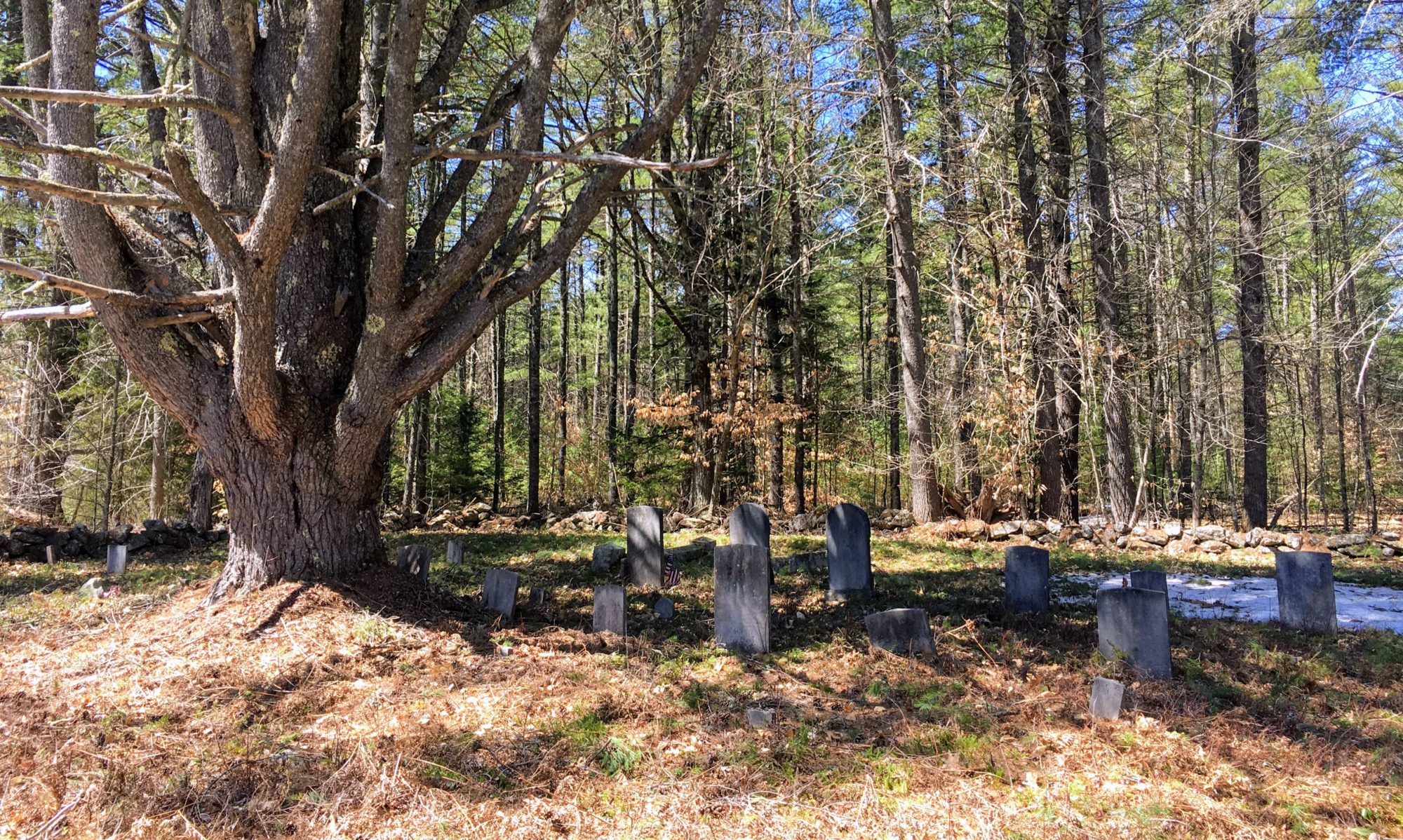
Location: 43.95460, -70.95615
From its intersection with Tibbetts Mountain Road, drive south on Haley Town Road less than 0.1 miles. Granite walls of the cemetery can be seen on the right (west) side of the road about 100′ in. Recent logging makes it visible, though one large oak tree still stands in the middle.
Historical Information:
Thomas Cotton lived on the southwest corner of Haleytown Road and Tibbetts Mountain Road, which was near the cemetery. Old records list that his wife Sarah and son Thomas Jr. are buried here. They also state that a child of a Mr. White who lived with the Cotton family (1812 or 1814), and perhaps Mr. White himself, are also buried here. (This is most likely Abraham White, who bought the land (Lot 33, B Range) in 1813.) At Pine Grove there is a monument with the names and dates of Thomas, Sarah and Thomas Jr., among others. This is not the original stone, since the old records provide age information and an epitaph that are not found on the newer monument.
Daniel and Peace (Morrill) Perkins lived here prior to Thomas Cotton and were allowed to stay until their deaths in 1840 and 1849. It is possible that they are buried in this cemetery, or in the larger nearby Marston Cemetery.
This cemetery first appeared on the deeds when Sarah A. Cotton (daughter of Thomas Cotton) sold a thirty acre plot that included the homestead to Albert E. Bean on 7/7/1906 (Book 96, Page 419): “Reserving in this deed a little cemetery lot situated about 20 rods south of buildings on said lot.” This description stayed when the property was sold from Albert Bean to Lizzie E. (Cotton) Bean 6/24/1909 (Book 98, Page 507). The current deed to Donald J. Barber does not include a description of the cemetery.
Condition (10/20/18):
One small marble headstone (Thomas, son of Thomas and Sarah Cotton) and its slotted base were uncovered but Sarah’s was not found. In June of 2019, Jess Davis cleaned and reset this small tablet in its base.
Large pieces of the granite walls on the north and east sides have fallen down the steep hillside. The west wall still stands with steps on the outside and inside of the cemetery. The south wall is fieldstone. The area has been heavily logged, though one large oak tree in the middle of the cemetery remains. The cemetery is small and probably contained no more than five people.

The following article, written by Jess Davis, appeared in the June 2019 Brownfield Historical Society Newsletter:
The Thomas Cotton Cemetery sits on a steep hill above the road, its split granite walls pushed over from a combination of gravity and the roots of a large maple tree. I grab my soil probe and head up the hill. After removing many years worth of downed branches I am able to give the ground a good search. In 1894 two gravestones were listed as being here, though the latest book of inscriptions from 1988 does not include them. Sure enough, about two inches below the surface I hear a telltale “tink” as my probe hits stone. I uncover a granite block with a slot in it to hold a marble gravestone. It is tipped backward, into the settled grave depression. I begin to probe behind the base and after awhile my efforts are rewarded. Under a full six inches of debris a small stone is buried with the inscription up: “My little flower/ O may it bloom/ A fadeless flower/ Beyond the tomb.”
Little Thomas Cotton was less than three months old when he died in 1841. The third and last child of Thomas and Sarah Cotton, he could have died of anything from cholera to the common cold. In a time before NICUs or even hospitals, the infant mortality rate was around 25%.
The elder Thomas Cotton was born in 1808 in Cornish and came to Brownfield around 1818 with his father, Elisha Cotton. They settled on what is now Haleytown Road and as the sons of the family grew older, Elisha gave them each a piece of his large tract, creating the Cotton neighborhood. Thomas built his house in the southwest corner of the intersection of Haleytown and Tibbetts Mountain Road. A rough stone cellar still remains at this location. The family graveyard is within sight further to the southwest.
When Thomas Cotton died in 1897, his obituary stated that “his house and outbuildings looked from the outside the same as it did upward of 50 years ago, without paint or extra finish” and that inside it contained old fashioned furniture and a stone fireplace. He never had a cook stove and attributed his long life to this fact. His wife Sarah, daughter of Obediah Clement, had died 18 years earlier and was buried next to her son. It is unknown whether Thomas Cotton Sr was buried there too, or whether he is in the lot of his son-in-law Charles W. Bickford in Pine Grove Cemetery. The names of the Cotton family are inscribed on the newer monument there.
I returned this spring to reset the tiny stone of the younger Thomas Cotton. As I leveled the base and set the tablet in sand mortar I thought about the family that created this graveyard. Although I never uncovered Sarah’s stone, I would think she would be happy to see her son’s upright again after all these years.
